
| 
| 
|
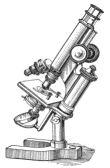
The optical property of a mineral depends on how it interacts with light. Several important optical properties are applicable to minerals and gemstones from a scientific standpoint. These properties are extremely useful for identifying a mineral. The most important of these properties are listed below
Colour - The colour of minerals is the result of the selective absorption of white light. The chemical structure of each mineral allows only certain wavelengths to be absorbed (the rest are reflected or pass through). In some minerals a single chemical element will be responsible for a particular colour. Copper minerals, for example, are blue or green. However, colour, although a useful property, cannot be used by itself to identify a specimen because many minerals have identical colours, and sometimes the same minerals have different colours. Compare the three stones below. They are similar in appearance - can you classify them? If not put your mouse over each picture to see what the mineral is.

| 
| 
|
However, identifying the "true colour" of a mineral, i.e. the absorption spectrum is a useful and practical method of gem identification. The optical instrument used to identify the absorption spectrum is called a spectroscope.
Transparency - apart from the obvious colour of a minerals (as discussed above), minerals can also be transparent, translucent or opaque. These properties depend on the amount of light being absorbed and the chemical structure of the rock; for example, what type of atomic bonds it has. So if no light is absorbed and all passes through the rock, the rock is transparent. Completely transparent minerals l have no colour. Diamond, for example, is transparent over a large range of wavelengths (from ultraviolet into the far infrared). On the other side of the spectrum we have opaque rocks which which absorb or reflect all light. And in the middle we have translucent rocks which admit light diffusely and as a result are partially transparent. When some opaque minerals are cut into thin sections they become translucent. Most polished gemstones are translucent.
Lustre - Lustre is a property of the surface of the mineral. The nature by which the surface reflects the light gives rise to different kinds of lustre which are independent of colour. It is important to know that lustre may vary on different faces of a crystal.
Metallic lustre - is the lustre of metals and minerals which absorb light strongly so they appear opaque even when cut into thin slices. All metals and some sulphides have a metallic lustre.
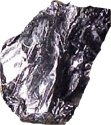 | Molybdenite MoS2 |
Adamantine lustre - transparent minerals with very high lustre. Adamantine lustre is the lustre of diamond and it is shown to perfection on the polished facets of a cut diamond. They are very few minerals with true adamantine lustre, an example being Anglesite Cuprite.
 | Diamond |
Vitreous lustre - the lustre of glass. This is the most common lustre among minerals.
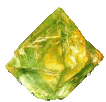 | Fluorite CaF2 |
Pearly lustre - is the result of light reflecting from the parallel surfaces, for example cleavage planes. The name comes from the glow which is reminiscent of a pearl. A typical example of a mineral with a pearly lustre is mica. Kyanite is another example of almost pearly lustre.
 | Kyanite Al2SiO5 |
Silky lustre - a silky appearance which results from a mineral having a fine fibrous structure. A typical example is asbestos. Some varieties of gypsum also have a silky lustre.
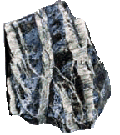 | Asbestos |
Earthy lustre - is a fancy name for minerals with a dull appearance. These minerals are microcrystalline or amorphous and have very poor reflective surfaces. Some hematites, such as that shown below have an earthy appearance, although other varieties have metallic or submetallic lustre.
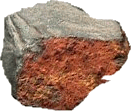 | Hematite Fe2O3 |
Reflection and refraction - light tends to travel in a straight line unless it encounters an obstacle - in our situation, a rock. In that case the angle of light will change. In the case of reflection the light bounces off of the surface and travels in a different direction. Refraction on the other hand results from the light changing direction, but without reflecting from a surface.
| Reflection
| Refraction
|
Index of refraction - how effective the mineral is in bending the light. It is a useful laboratory diagnostic technique. The refraction index of a diamond is 2.4.For most minerals the index of refraction is between 1.4 - 2.0.
Streak - is the colour of a mineral in powdered form. The best way to determine streak is to smear the powder on the white porcelain. Whereas the colour of the minerals can be very variable, the colour of a streak is less so. Streak is particularly useful in identifying opaque and coloured minerals, but is is not very useful when it comes to silicates. Silicates are very hard and therefore difficult to powder, and their streak is almost always white.
Fluorescence - when put under UV light some minerals emit light in the visible part of the spectrum. A typical example being fluorite, but many other minerals can fluoresce under UV light. Although putting your fluorescent minerals under a UV lamp can hugely enhance the beauty of your specimen ,this property has little diagnostic value. Below is an example of a rock under both normal and UV light.
 | 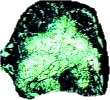
|
| _______________________________ | ||||
| Home | | | Shopping | | | Database |
© Biscuit Software 2004-2015
All rights reserved